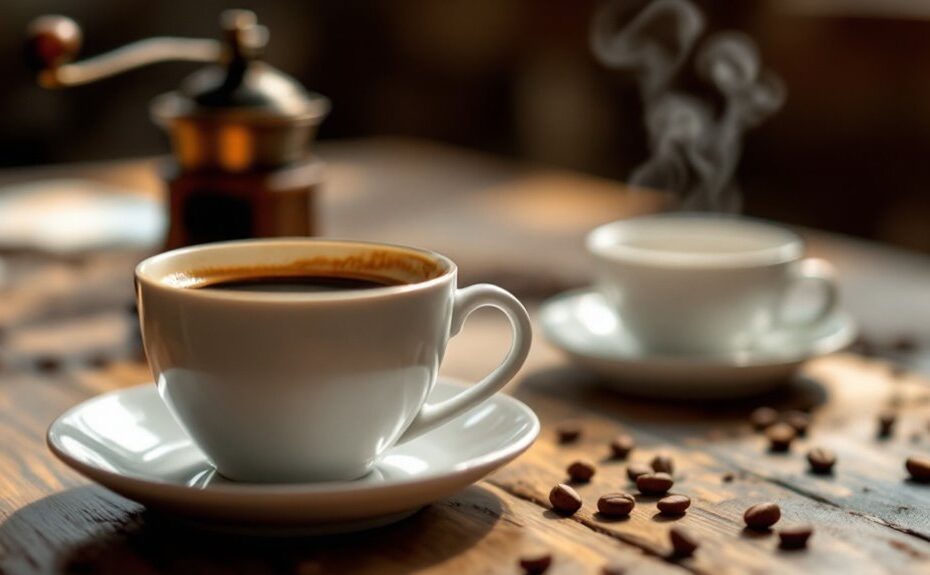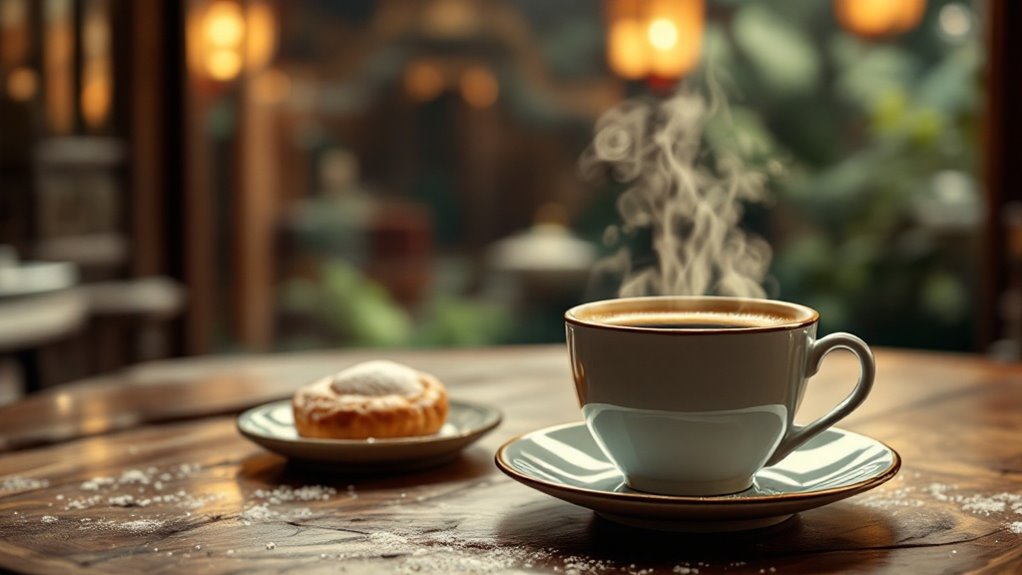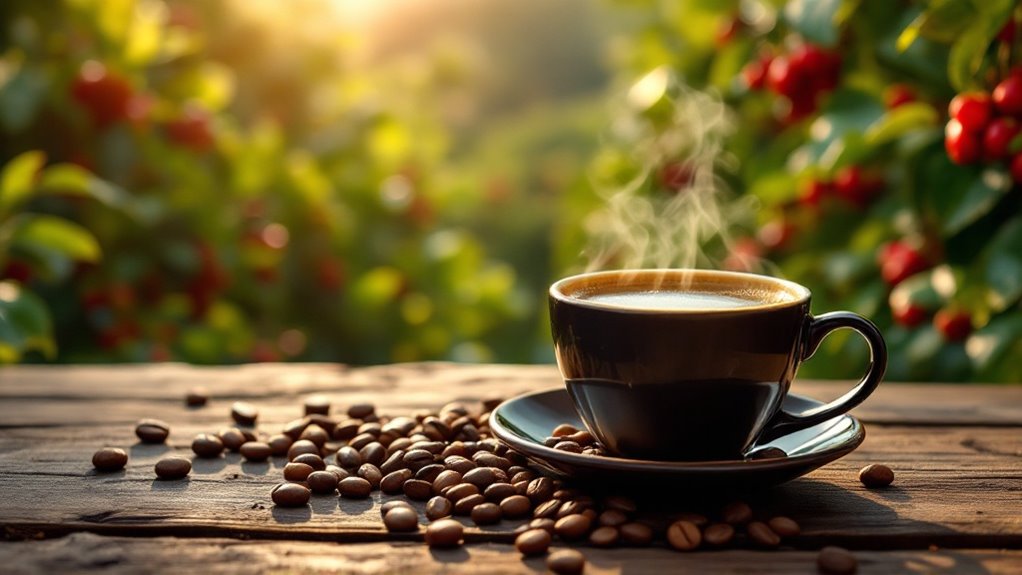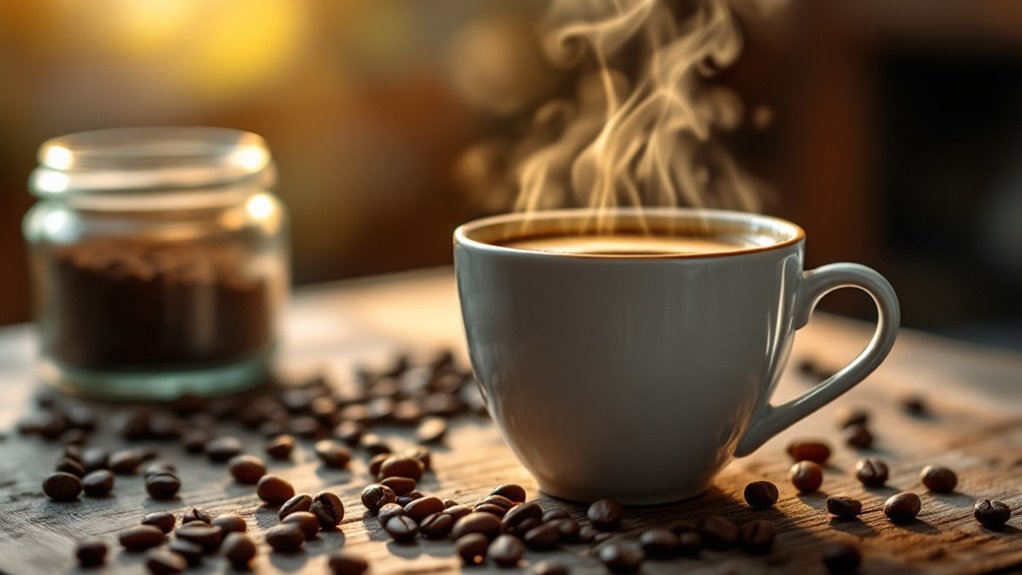







Imagine standing in a Venetian piazza, the steam from your espresso curling into the crisp morning air like a whispered secret. Italy's coffee culture isn't just about the drink—it's a ritual, a moment of pause in a bustling day. But with so many iconic brands like Lavazza and Illy, historic cafés, and regional specialties, how do you decide what truly defines the best coffee in Italy? The answer isn't just in the beans or the brew; it's in the experience. So, where do you start to uncover the essence of Italian coffee? The journey's just beginning.
Key Takeaways
- Caffe Florian in Venice, Italy's oldest café, is renowned for its historic ambiance and cultural significance.
- Antico Caffe Greco in Rome, established in 1760, is celebrated for its rich history and association with famous intellectuals.
- Lavazza and Kimbo are iconic Italian coffee brands, offering bold, intense blends perfect for espresso and Moka pot brewing.
- Ditta Artigianale in Florence is a modern favorite, known for its artisanal approach and meticulously sourced coffee beans.
- Caffè Al Bicerin in Turin is famous for its layered coffee drink, reflecting local traditions and unique flavors.
Iconic Italian Coffee Cafés
When you think of Italian coffee culture, iconic cafés like Caffe Florian in Venice immediately come to mind. Established in 1720, it's Italy's oldest café, where you'll sip espresso under gilded mirrors and frescoes, surrounded by the echoes of Charles Dickens and Lord Byron. In Rome, Antico Caffe Greco, founded in 1760, offers a similar allure. Its velvet-lined interiors and marble tables have hosted luminaries like Goethe and Casanova, making it a living museum of intellectual history. These cafés aren't just about coffee; they're time capsules where every cup feels like a brush with the past. You'll find yourself immersed in an atmosphere where tradition and artistry blend seamlessly, proving that Italian coffee culture is as much about the experience as it is about the brew.
Artisanal Coffee Roasters in Italy
While Italy's iconic cafés often steal the spotlight, the country's artisanal coffee roasters are the unsung heroes behind its world-renowned coffee culture. In Florence, Ditta Artigianale stands out for its meticulously sourced coffee beans, offering a rich espresso that's a reflection of their craft. Venice's Torrefazione Cannaregio, one of the few with a roasting license, delivers a flawless espresso, showcasing the depth of artisanal coffee. Nearby, Caffe del Doge, one of Venice's pioneering roasters, blends tradition with innovation, perfect for sipping near the Rialto Bridge. In Rome, La Casa del Caffe Tazza d'Oro roasts its beans in-house, creating a signature granita al caffe that's unforgettable. Marchini Time, though a grab-and-go spot, guarantees every cup reflects the precision of artisanal roasting. These roasters elevate Italy's coffee legacy.
Popular Italian Coffee Brands
Though Italy's artisanal roasters craft exceptional coffee, its popular coffee brands have become household names, shaping the global perception of Italian coffee culture. Lavazza, founded in 1895, dominates the market with blends like Crema e Aroma, offering a medium roast perfect for espresso coffee. Kimbo, rooted in Naples, delivers robust, medium-dark roasts like Aroma Gold, embodying traditional Neapolitan flavors. Pellini, from Verona, excels with Arabica blends such as Aroma Oro, known for their chocolaty and fruity notes. Danesi Caffè, established in 1905, balances intensity with floral undertones in its Classic blend. Mokaflor, a Florentine roaster, stands out with artisanal blends like Rosso, featuring nutty, chocolaty profiles. These brands define Italian coffee, blending tradition and innovation to create espresso coffee that's both iconic and accessible.
Types of Italian Coffee Drinks
You'll find espresso at the heart of Italian coffee culture, a bold, concentrated shot served in a tiny cup and meant to be savored quickly. For a creamier experience, try a cappuccino, where espresso meets velvety steamed milk and a thick layer of foam, though you'll rarely see locals ordering it past mid-morning. If you prefer a milder option, a caffè latte offers a smoother balance with more milk and less foam, perfect for easing into your day.
Espresso and Variations
Espresso, or "caffè" as it's known in Italy, is the cornerstone of Italian coffee culture, a concentrated shot of bold flavor that's both simple and complex in its execution. A single shot of espresso delivers a rich, velvety texture with a balance of bitterness and sweetness, often crowned with a golden crema. For a more intense experience, try a caffè ristretto, which uses less water, amplifying the coffee's depth. If you prefer a milder option, caffè lungo stretches the extraction, offering a lighter but still robust profile. For a spirited twist, caffè corretto adds a splash of liquor, transforming your espresso into a post-meal treat. And if one shot isn't enough, a caffè doppio doubles the intensity, perfect for those who crave a stronger caffeine kick.
Milk-Based Coffee Drinks
While espresso forms the backbone of Italian coffee culture, milk-based coffee drinks offer a creamy, indulgent counterpoint that's equally iconic. Start your morning with a cappuccino, where Italian espresso meets equal parts steamed milk and velvety foam—just don't order it past 11 AM, as Italians consider it a breakfast-only treat. For a lighter option, try a caffè latte, blending espresso with more steamed milk for a smooth, mellow Italian coffee drink. If you prefer visual appeal, a latte macchiato layers hot or cold milk with a hint of espresso in a tall glass. For something richer, the marocchino combines espresso, cocoa powder, and milk foam in a small cup. Or, opt for a caffè macchiato, where a splash of milk softens the intensity of Italian espresso without overwhelming it.
Italian Coffee Culture and Traditions
Italian coffee culture is deeply rooted in tradition, where the ritual of drinking espresso is both a daily necessity and a cherished social practice. In an authentic Italian setting, you'll notice locals standing at the bar, quickly sipping their espresso before heading off to work or meeting friends. This isn't just about efficiency—it's a cultural norm. Cappuccino, a milk-based drink, is reserved for mornings, as Italians believe it disrupts digestion later in the day. Historical cafés like Caffe Florian have long been cultural hubs, blending coffee with art and intellectual exchange. When you order, you'll pay at the cashier first, then present your receipt to the barista. Standing at the bar is not only economical but also immerses you in the true Italian coffee experience.
How to Order Coffee in Italy
Understanding the nuances of ordering coffee in Italy is key to blending in with local customs and enjoying the experience authentically. Start by paying at the cashier and presenting your receipt to the barista. If you're on a budget, drink your coffee standing at the bar—sitting at a table can double the cost. To order a standard espresso, simply say "un caffè"; specifying "espresso" is redundant. For a bolder Espresso Roast, ask for a "ristretto," or opt for a "lungo" if you prefer a milder brew. Remember, cappuccino is a morning ritual and rarely ordered after 11 AM. Mastering these details guarantees you savor Italy's coffee culture like a local, without unnecessary missteps.
Regional Coffee Specialties
Northern Italian roasts often surprise you with their light, aromatic profiles, perfect for savoring in Venice's historic cafés or Florence's artisanal roasteries. In contrast, Neapolitan dark blends hit you with their bold, intense flavors, a reflection of the city's love for strong, crema-topped espresso. Each region's coffee tells a story, mirroring its culture and traditions in every sip.
Northern Italian Roasts
While Italy is globally celebrated for its coffee culture, Northern Italian roasts stand out for their meticulous craftsmanship and distinctive flavor profiles. These high-quality blends, often featuring a higher percentage of arabica beans, deliver a smoother, less bitter taste compared to their southern counterparts. Brands like Hausbrandt and Pellini excel in artisanal roasting, using slow-roasting techniques that exceed 20 minutes to enhance longevity and depth. The result is a medium to dark roast with balanced intensity, often showcasing chocolaty or nutty aromas that appeal to traditional Italian preferences. Freshness is paramount, with many roasters offering beans roasted to order, ensuring your ground coffee delivers peak flavor for espresso or other brewing methods. Northern Italian roasts are a reflection of precision and tradition, offering a rich, aromatic experience.
Neapolitan Dark Blends
Though Northern Italian roasts are celebrated for their smoothness, Neapolitan dark blends take a bolder approach, delivering an intense, full-bodied experience that's deeply rooted in tradition. These famous Italian coffee blends, like Kimbo il Caffè Di Napoli – Intenso, are roasted longer and darker, often with 20% or more robusta, creating a rich, chocolatey flavor with nutty undertones. The Italian Roast style here is unmistakable—think smoky, robust, and unapologetically strong, with intensity ratings hitting 12/13. Brands like Passalaqua and Barbera have perfected this art, crafting dark blends that shine in a stovetop Moka pot, the preferred brewing method in Naples. If you crave a coffee that's as bold as it is traditional, Neapolitan dark blends are your go-to for an authentic, powerful espresso experience.
Tips for Brewing Italian Coffee at Home
To brew authentic Italian coffee at home, you'll need to master the art of precision and technique, starting with the right equipment and ingredients. A Moka pot is essential for stovetop brewing—fill it with water just below the safety valve and distribute finely ground coffee evenly without tamping. Use Italian coffee blends like Lavazza or Illy, roasted specifically for espresso or Moka pots, to achieve that rich, bold flavor. Grind your beans to a fine consistency, resembling table salt, for ideal extraction. Preheat water to 90-96°C (194-205°F) to avoid bitterness and over-extraction. Clean your Moka pot or espresso machine regularly to prevent residue buildup, which can ruin the taste. With these steps, you'll capture the essence of Italian coffee in every cup.
Best Cities for Coffee in Italy
Italy's coffee culture is as rich and varied as its history, and exploring its cities reveals a world of tradition, innovation, and passion for the perfect cup. In Rome, you'll find historic cafés like Antico Caffe Greco and La Casa del Caffe Tazza d'Oro, where in-house roasting guarantees the best coffee. Florence blends old-world charm with modern techniques at Caffe Gilli and Ditta Artigianale, offering artisanal types of Italian coffee. Venice boasts Caffe Florian, Italy's oldest café, and Torrefazione Cannaregio, a rare gem with a roasting license. Naples is synonymous with strong, dark-roasted espresso, perfected by roasters like Passalaqua. In Turin, Caffè Al Bicerin serves its iconic layered drink, a reflection of the city's elegant coffee traditions. Each city offers a unique take on Italy's beloved coffee culture.
Disclosure: As an Amazon Associate, I earn from qualifying purchases.






